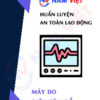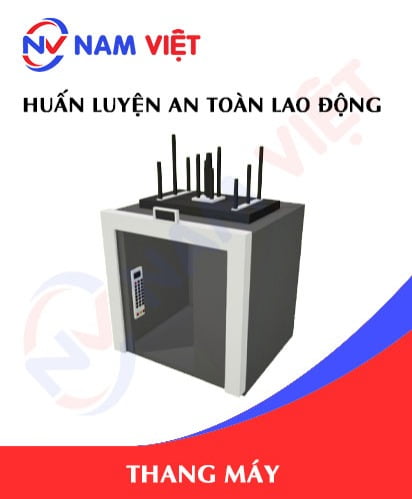Occupational Safety Training for Operating Hematology Analyzers
99,000 ₫
Note: The above price is calculated per person and may vary depending on the number of trainees participating in the course and market fluctuations. For more accurate pricing support, please refer to the pricing list or contact our consulting staff directly.
Occupational safety is an important issue when operating the Hematology Analyzer and needs to be addressed promptly to ensure the health and safety of workers and enhance the reputation of businesses here. The Occupational Safety Training is one of the effective solutions to raise awareness on how to prevent occupational accidents for workers operating the Hematology Analyzer.
Table of Contents
Toggle1. Overview of Hematology Analyzer
a. What is a Hematology Analyzer?
A Hematology Analyzer is a medical device used to automatically analyze the components of blood. Its main purpose is to assess key hematological parameters such as the count and ratio of blood cells (red blood cells, white blood cells, and platelets), hemoglobin levels, cell size and shape, along with other parameters related to hematological abnormalities.
Modern hematology analyzers typically use electrochemical, spectroscopic, and cell counting technologies to analyze blood samples. Cell counting techniques often rely on a single-cell flow method, where the blood sample is separated into individual cells and counted using light sensors or electrodes. Parameters are determined after the blood sample is processed and measured by sensors and analyzed by computer software.
Hematology analyzers provide fast and accurate results, helping doctors and healthcare staff diagnose and monitor hematological conditions such as anemia, congenital blood disorders, cancer, and other blood-related diseases. Automation reduces errors, improves accuracy compared to manual assessment, and saves time and effort in analyzing blood samples.

b. How a Hematology Analyzer Works
The operation of a hematology analyzer is based on several techniques to analyze blood components. Key principles include:
- Cell counting principle: One of the most common methods counts blood cells using light or electrodes to tally the number of cells passing through a fixed area. The analyzer counts individual cells and identifies the number of different types such as red blood cells, white blood cells, and platelets.
- Shape and size analysis: Optical sensors measure cell size and shape. By analyzing these, the analyzer can detect abnormalities such as deformation or enlargement of cells.
- Hemoglobin content analysis: Some analyzers use spectroscopy to measure hemoglobin levels in the blood sample, providing accurate and automated hemoglobin readings.
- Hematocrit and red cell indices: Analyzers calculate hematological parameters such as hematocrit (the proportion of red blood cells in a blood sample) and MCV (mean corpuscular volume).
- Sample processing and data analysis: After the sample is loaded, it is processed to remove interferences and prepared for analysis. Data from measurements is processed by integrated software to determine hematological parameters and generate reports.

c. Industries Using Hematology Analyzers
Hematology Analyzers are primarily used in the medical field and healthcare-related industries. Key sectors include:
- Clinical medicine: In hospitals, clinics, and primary healthcare centers, analyzers assess and monitor patient health. Doctors and healthcare staff use them to diagnose and treat hematological conditions such as anemia, congenital blood disorders, and blood cancers.
- Medical research: Researchers use analyzers to study blood samples from clinical trials and basic research to understand disease mechanisms and develop new treatments.
- Pharmaceutical and diagnostic industries: Analyzers support drug development and efficacy testing. Diagnostic companies also use them to provide hematology testing services for patients and healthcare providers.
- Animal science and veterinary research: Analyzers evaluate the hematological health of laboratory and farm animals.

2. Overview of Occupational Safety Training for Operating a Hematology Analyzer
a. What is Occupational Safety Training?
- Occupational safety training for operating a Hematology Analyzer equips workers with knowledge to prevent workplace accidents. Employees directly operating the analyzer belong to Group 3.
- The training helps workers recognize hazards, reduce risks, and prevent accidents while performing their tasks.
REGISTER FOR OCCUPATIONAL SAFETY TRAINING
b. Training Duration
Initial Safety Training:
- Total training duration is at least 24 hours, including exam time.
- 8 hours of theory on occupational safety policies and laws
- 8 hours of theory on basic occupational safety knowledge
- 4 hours of theory on specialized training content
- 2 hours of practical training on specialized content
- 2 hours of theoretical exam at the end of the course
Training centers schedule sessions based on employee availability. Typically, there are 6 sessions over 3 days, if the company allows continuous study.
Periodic Safety Training:
- Before an Occupational Safety Card expires, workers must complete periodic training, with duration at least 50% of the initial training.
Explanation: total duration of periodic training is at least 12 hours, including exam time. After passing the training and exam, the worker receives a renewed Occupational Safety Card.
c. Training Content
| No. | TRAINING CONTENT | TRAINING HOURS | |||
| Total | Including | ||||
| Theory | Practice | Exam | |||
| I | Occupational safety policies and laws | 8 | 8 | 0 | 0 |
| 1 | Overview of legal documents on occupational safety and hygiene. | 6 | 6 | ||
| 2 | Standards and technical regulations for occupational safety and hygiene. | 1 | 1 | ||
| 3 | Specific regulations by state authorities on occupational safety when constructing, expanding, or upgrading production facilities, machines, equipment, and materials requiring strict safety and hygiene measures. | 1 | 1 | ||
| II | Basic knowledge of occupational safety and hygiene | 8 | 8 | 0 | 0 |
| 1 | Basic knowledge of workplace hazards and harmful factors. | 4 | 4 | ||
| 2 | Methods to improve working conditions. | 1 | 1 | ||
| 3 | Safety culture in production and business. | 1 | 1 | ||
| 4 | Rights and obligations of employers and employees; safety policies and procedures; functions of the safety network. | 1 | 1 | ||
| 5 | Safety rules, signage, using safety equipment and PPE; first aid and occupational disease prevention skills. | 1 | 1 | ||
| III | Specialized training content | 6 | 4 | 2 | 0 |
| Comprehensive knowledge of machines, equipment, hazardous materials; risk assessment and management; safe working procedures for specialized machinery and substances. | 6 | 4 | 2 | ||
| IV | Final safety training assessment | 2 | 2 | 0 | 0 |
| Total | 24 | 22 | 2 | ||
See more training content of the 6 groups
d. Occupational Safety Card
After completing the occupational safety training and passing the exam, workers receive a Group 3 Occupational Safety Card (commonly called Group 3 Safety Certificate).
The card includes personal information such as name, date of birth, specific job and work environment, training duration, and certification with stamp and signature.
According to Clause 2 of Article 24 of Decree 44/2016/ND-CP, there are two cases:
- If the worker has a labor contract, the employer must stamp and sign the card after training and passing the exam.
- If the worker is freelance or seasonal without a labor contract, the training unit must stamp and sign the card after training and passing the exam.

3. Hazards for Workers Operating a Hematology Analyzer
Operating a hematology analyzer can pose several hazards for workers, including:
- Chemical exposure risk: Some hematology analyzers require the use of chemical solutions for pre-processing blood samples or preparing control solutions. Workers may be exposed to these chemicals through skin contact, inhalation, or ingestion, leading to toxic or harmful health effects.
- Infection risk: During operation and handling of blood samples, exposure to patients’ blood can occur. If safety measures are not followed, there is a risk of contracting infectious diseases transmitted through blood, including HIV, hepatitis viruses, and others.
- Electrical safety risk: Some hematology analyzers use high-voltage power sources or contain complex electronic components. Failure to follow electrical safety rules may result in electric shock accidents.
- Bloodborne pathogen risk: During operation, accidents may cause injuries that breach the skin, creating a risk of infection from patients’ blood cells.
- Radiation risk: Certain hematology analyzers use radiation-based technologies such as spectroscopy for sample analysis. Improper use can pose radiation hazards to workers.

4. Occupational Safety Measures When Operating a Hematology Analyzer
To control occupational accidents when operating a hematology analyzer, several safety measures and procedures must be followed. Here are some basic control measures:
- Training and guidance: All staff must be trained on the proper use and operation of hematology analyzers. Guidance should include the use of personal protective equipment (PPE), procedures for handling blood samples and chemicals, and electrical safety measures.
- Use of personal protective equipment (PPE): Ensure all operators wear proper PPE such as gloves, masks, eye protection, and lab coats to protect against blood, chemical, and radiation hazards.
- Safe work procedures: Implement safe work procedures including blood sample handling, cleaning and maintenance of the analyzer, and proper medical waste disposal.
- Regular inspection and maintenance: Ensure the hematology analyzer is periodically inspected and maintained to guarantee safe and efficient operation.
- Monitoring and supervision: Provide adequate supervision to ensure all staff follow safety rules and implement accident control measures.
- Workplace organization: Ensure the workspace is clean and well-organized, especially around the hematology analyzer, to prevent slips, trips, or unintended collisions.
- Emergency and fire response: Train staff on handling incidents such as blood sample spills, collisions, or fire hazards.
- Reporting and evaluation: Encourage immediate reporting of any incidents, accidents, or safety issues and reassess control measures to improve workplace safety.
- Periodic inspection of the hematology analyzer to detect safety issues such as wear, tear, or mechanical malfunctions, thereby reducing the risk of occupational accidents.
5. Benefits of Occupational Safety Training
An Toàn Nam Việt provides your business with the following benefits upon completing occupational safety training courses in accordance with Decree 44/2016/ND-CP regarding occupational safety and hygiene for companies and enterprises:
- Workers can identify potential occupational hazards and take preventive measures to avoid accidents.
- Your business can establish risk prevention measures in production, operation, and maintenance processes.
- Minimizes costs associated with workplace safety risks.
- Uninterrupted production helps increase labor productivity and product quality.
- Ensures compliance with occupational safety regulations, reducing legal risks.
- Enhances credibility and professionalism, thereby elevating your company’s brand.
Nam Việt’s training courses serve as a preventive solution against external hazards, helping individuals avoid injuries or even fatal accidents.
REGISTER FOR OCCUPATIONAL SAFETY TRAINING SERVICE
6. Customer Feedback After Completing the Training
An Toàn Nam Việt has years of experience accompanying many businesses in Vietnam, particularly in the southern provinces. This responsibility is invaluable to us, which is why our occupational safety training is increasingly professional. The motivation for our growth comes from positive feedback and suggestions from enterprises we serve. Below are some testimonials from our clients.
See more customer interviews after using the service from An Toàn Nam Việt
7. An Toàn Nam Việt’s Occupational Safety Training Capability
An Toàn Nam Việt is a reputable center for occupational safety training in Vietnam. Training sessions are conducted continuously in factories, workshops, and construction sites across all 63 provinces in Vietnam.
REGISTER FOR OCCUPATIONAL SAFETY TRAINING SERVICE
Occupational Safety Training License
- An Toàn Nam Việt has been inspected and certified by the Department of Safety, Ministry of Labor – Invalids and Social Affairs to meet the conditions for occupational safety and hygiene training. This strengthens our training capabilities.

Training Materials and Lectures
- Before being used in OSH training courses, all materials are reviewed to ensure accuracy and effectiveness.
- Teaching methods follow Nam Việt’s standards, developed by experts in occupational safety and hygiene training for optimal knowledge absorption.
Facilities
- Control of classroom factors enhances teaching efficiency and knowledge retention.
- Our training facilities provide spacious classrooms meeting standards for area, lighting, and training equipment.
8. Nationally Reputable Occupational Safety Training Center
At An Toàn Nam Việt, we prioritize occupational safety training. Teaching workers how to protect themselves equips them with safety skills for their careers and contributes to national development.
We meticulously prepare all training tools, teaching equipment, curricula, materials, sound, and lighting to ensure training effectiveness.
Our trainers are experts with years of experience and research in hazard identification and prevention across all industries. Lectures are practical, engaging, and aligned with Decree 44/2016/ND-CP.
Our training center is proud to provide professional, reliable occupational safety training with advantages including:
- Competitive training costs while ensuring quality.
- Flexible schedules aligned with company operations.
- Quick and compliant certification procedures.
- Experienced trainers with extensive professional background.
- Classroom conditions optimized for teaching efficiency and knowledge absorption.
- Lectures tailored to workplace safety requirements of enterprises.
- Dedicated, professional support to clients quickly and accurately.

9. Additional Occupational Safety Training Resources
- Occupational Safety Training Materials
- Safety Materials for Operating Automated Hematology Analyzers
- Occupational Safety Test Materials
- Multiple-choice Test on Operating Automated Hematology Analyzers
- Slides for Occupational Safety Training on Automated Hematology Analyzer Operation
1 review for Occupational Safety Training for Operating Hematology Analyzers
No comments yet















phanminhhang341
Good labor safety unit